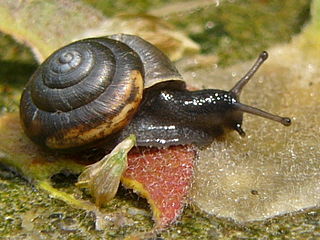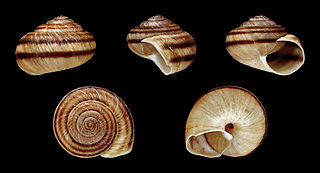
Helicoidea is a taxonomic superfamily of air-breathing land snails, terrestrial pulmonate gastropod mollusks in the clade Stylommatophora.

Discula is a genus of small land snails, terrestrial pulmonate gastropod mollusks in the family Geomitridae.

Actinella is a genus of land snails in the family Geomitridae.
Hystricella bicarinata is a species of air-breathing land snail, a terrestrial pulmonate gastropod mollusk in the family Geomitridae, the hairy snails and their allies.
Discula bulverii is a species of air-breathing land snail, a terrestrial pulmonate gastropod mollusk in the family Geomitridae.
Hystricella echinulata is a species of air-breathing land snail, a terrestrial pulmonate gastropod mollusc in the family Geomitridae, the hairy snails and their allies.

Lampadia webbiana is a species of land snail in the family Helicidae, the true snails. It is endemic to the Madeira archipelago, Portugal. The species is named after botanist Philip Barker-Webb.

Pseudocampylaea portosanctana is a species of air-breathing land snail, a terrestrial pulmonate gastropod mollusk in the family Geomitridae, the hairy snails and their allies.

Hygromiidae is a taxonomic family of small to medium-sized air-breathing land snails, terrestrial pulmonate gastropod mollusks in the superfamily Helicoidea.

Cal Islet is a small island about 500 m (1,600 ft) south of Porto Santo Island, in the Madeira Archipelago, Portugal. With an area of 1.40 km2 (0.54 sq mi), Cal is the largest of six islets close to Porto Santo. The highest point is 178 m (584 ft). The islet has never been inhabited.

Wollastonaria is a genus of gastropod molluscs in the subfamily Geomitrinae of the family Geomitridae.

Obelus is a European genus of small air-breathing land snails, terrestrial pulmonate gastropod mollusks in the subfamily Geomitrinae of the family Geomitridae, the hairy snails and their allies.
Hystricella is a genus of air-breathing land snails, terrestrial pulmonate gastropod mollusks in the subfamily Geomitrinae of the family Geomitridae, the hairy snails and their allies.

Ilhéu de Cima is a small island about 400 meters off the east coast of Porto Santo Island, Madeira, Portugal. Its area is 30.07 ha. The islet is 121 meters high, bare and nearly flat, with steep cliffs towards the sea. It is the easternmost point of the Madeira archipelago. It is part of the Network of Marine Protected Areas of Porto Santo (RAMPPS), which covers the six islets around Porto Santo and the marine areas surrounding them. There is a lighthouse on the northeastern part of the island. It is a 15 m high masonry tower, with focal height 124 m. It went into operation in 1901.

Geomitridae is a taxonomic family of small to medium-sized air-breathing land snails, terrestrial pulmonate gastropod mollusks in the superfamily Helicoidea.

Plebecula is a genus of land snails in the subfamily Geomitrinae of the family Geomitridae.
Domunculifex is a genus of land snails in the family Geomitridae.













